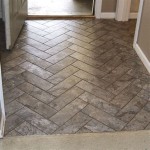Kitchen Floor Tile Ideas for White Cabinets: A Comprehensive Guide
Selecting the right flooring for a kitchen with white cabinets requires careful consideration of aesthetics, functionality, and practicality. The flooring material not only needs to complement the clean, bright look of white cabinetry but also withstand the demands of a high-traffic area prone to spills and messes. This article explores various kitchen floor tile ideas that harmonize with white cabinets, providing a detailed overview of materials, styles, and design principles.
Tile Materials: Performance and Aesthetics
The choice of tile material significantly impacts the overall look and performance of the kitchen floor. Several materials are popular choices, each offering distinct advantages and disadvantages with white cabinets. Factors such as durability, water resistance, maintenance requirements, and cost should all be weighed before making a decision.
Porcelain Tile: Porcelain tiles are a versatile and highly durable option for kitchen flooring. Fired at high temperatures, porcelain offers exceptional resistance to scratches, stains, and water damage. Its dense composition makes it suitable for high-traffic areas and resists chipping. Porcelain tiles are available in a wide range of colors, patterns, and sizes, allowing for diverse design possibilities. When paired with white cabinets, porcelain tiles can create a clean, modern aesthetic. Large-format porcelain tiles, in particular, can minimize grout lines and enhance the feeling of spaciousness. Furthermore, porcelain can mimic the look of natural stone, wood, or concrete at a lower cost and with easier maintenance.
Ceramic Tile: Ceramic tiles are another common choice for kitchen floors. While similar to porcelain, ceramic tiles are generally less dense and absorbent, making them less resistant to water damage. However, ceramic tiles are still a durable option for many kitchens and offer a wide variety of designs and colors. They are typically more affordable than porcelain, making them a budget-friendly choice. When selecting ceramic tiles for a kitchen with white cabinets, it is crucial to choose a finish that is resistant to stains and easy to clean. Consider using a sealant to further protect the tile and grout from moisture.
Natural Stone Tile: Natural stone tiles, such as marble, granite, slate, and travertine, provide a sophisticated and unique look for kitchen flooring. Each type of stone offers distinct characteristics in terms of color, pattern, and texture. Marble, for example, offers a luxurious and elegant appearance but requires regular sealing to prevent staining. Granite is highly durable and resistant to heat and scratches, making it a practical choice for kitchens. Slate offers a rustic and natural look, while travertine provides a warm and textured feel. Natural stone tiles can complement white cabinets by adding depth, character, and a touch of luxury. However, natural stone generally requires more maintenance than porcelain or ceramic tiles.
Vinyl Tile: Vinyl tile, particularly luxury vinyl tile (LVT), has become an increasingly popular flooring option for kitchens due to its durability, water resistance, and affordability. LVT is available in a wide range of styles that mimic the look of wood, stone, and ceramic. It is also relatively easy to install and maintain. When paired with white cabinets, vinyl tile can create a variety of design styles, from modern and minimalist to traditional and rustic. LVT is also softer underfoot than porcelain or ceramic, providing added comfort. Furthermore, LVT is often more resistant to temperature changes than other tile options, making it suitable for kitchens with radiant floor heating.
Cement Tile: Cement tiles, also known as encaustic tiles, offer a unique and vibrant look for kitchen flooring. These tiles are handmade and feature intricate patterns and bold colors. Cement tiles are durable and can last for many years with proper care. When paired with white cabinets, cement tiles can add personality and visual interest to the kitchen. However, cement tiles require sealing to protect them from stains and water damage. They are also generally more expensive than porcelain or ceramic tiles. Furthermore, the installation of cement tiles requires specialized skills and expertise.
Color Palette and Design Considerations
The color and design of the kitchen floor tile play a crucial role in complementing the white cabinets and establishing the overall aesthetic of the space. A careful selection of colors, patterns, and tile layouts can enhance the visual appeal and functionality of the kitchen.
Neutral Tones: Neutral tones, such as gray, beige, and cream, are a popular choice for kitchen floor tiles with white cabinets. These colors create a timeless and versatile look that complements a wide range of design styles. Gray tiles, in particular, can provide a modern and sophisticated contrast to white cabinets. Beige and cream tiles offer a warmer and more inviting feel. Neutral tones also provide a blank canvas for adding pops of color through accessories, such as rugs, kitchen towels, and appliances. When selecting neutral-toned tiles, consider the undertones of the white cabinets. Warmer white cabinets pair well with beige or cream tiles, while cooler white cabinets complement gray tiles.
Contrasting Colors: Contrasting colors, such as black, navy blue, or deep green, can create a bold and dramatic look in a kitchen with white cabinets. Black tiles, for example, offer a striking contrast that adds a touch of sophistication and elegance. However, black tiles can also make the room feel smaller, so it is important to use them sparingly. Navy blue tiles can provide a nautical or coastal-inspired feel, while deep green tiles offer a natural and earthy aesthetic. When using contrasting colors, it is important to balance the look with other elements in the kitchen, such as countertops and backsplash. Consider using lighter-colored countertops to offset the darkness of the floor tiles.
Patterned Tiles: Patterned tiles can add visual interest and personality to a kitchen with white cabinets. Geometric patterns, such as hexagons, chevrons, or Moroccan-inspired designs, can create a modern and eclectic look. Floral patterns or vintage-inspired designs can add a touch of charm and nostalgia. When using patterned tiles, it is important to consider the scale of the pattern and the size of the kitchen. Smaller kitchens may benefit from smaller-scale patterns, while larger kitchens can accommodate larger and bolder patterns. It is also important to balance the patterned tiles with simpler elements in the kitchen to avoid overwhelming the space.
Tile Layouts: The layout of the tiles can also significantly impact the overall look of the kitchen floor. A straight layout is a classic and simple choice that works well in most kitchens. A staggered layout, also known as a brick pattern, can add a touch of visual interest. A diagonal layout can make a small kitchen feel larger. Herringbone and chevron patterns create a more dynamic and sophisticated look. Consider the size and shape of the tiles when choosing a layout. Rectangular tiles, for example, work well in staggered or herringbone patterns, while square tiles are often used in straight or diagonal layouts.
Grout Color: The color of the grout can also affect the overall aesthetic of the kitchen floor. A grout color that matches the tile can create a seamless and uniform look. A contrasting grout color can highlight the shape and pattern of the tiles. Light-colored grout can make the floor feel brighter, while dark-colored grout can hide dirt and stains. When selecting a grout color, consider the material and color of the tiles. Natural stone tiles, for example, often look best with a grout color that closely matches the stone. Porous tiles may require a sealant to protect the grout from staining.
Practical Considerations and Maintenance
Beyond aesthetics, the practicality and maintenance requirements of kitchen floor tiles are critically important. Kitchens are high-traffic areas prone to spills, stains, and general wear and tear. Selecting tiles that are durable, easy to clean, and resistant to damage is crucial for long-term satisfaction.
Durability and Slip Resistance: Durability is a key factor when choosing kitchen floor tiles. The tiles should be able to withstand the wear and tear of daily use, including foot traffic, dropped objects, and spills. Porcelain tiles are generally the most durable option, followed by ceramic tiles and natural stone. Vinyl tiles are also a durable option, particularly LVT. Slip resistance is another important consideration, especially in kitchens where spills are common. Tiles with a textured surface provide better grip and reduce the risk of slipping. Consider selecting tiles with a slip-resistance rating that is appropriate for a kitchen environment.
Water Resistance and Stain Resistance: Water resistance is essential for kitchen floor tiles, as kitchens are prone to spills and moisture. Porcelain and vinyl tiles are highly water-resistant, making them ideal choices for kitchens. Ceramic tiles are less water-resistant but can be sealed to improve their performance. Natural stone tiles vary in their water resistance, with some types requiring regular sealing. Stain resistance is also important, especially for light-colored tiles. Choose tiles that are resistant to common kitchen stains, such as grease, oil, and food spills. Consider using a sealant to protect the tiles and grout from staining.
Cleaning and Maintenance: The ease of cleaning and maintenance is a crucial factor to consider when selecting kitchen floor tiles. Porcelain and vinyl tiles are generally easy to clean with mild soap and water. Ceramic tiles can also be cleaned with similar methods. Natural stone tiles may require specialized cleaning products and techniques. Avoid using abrasive cleaners or harsh chemicals that can damage the tiles. Regular sweeping or vacuuming can help prevent dirt and debris from accumulating on the floor. Grout lines can be cleaned with a grout brush and a mixture of baking soda and water. Consider using a grout sealant to protect the grout from staining.
Cost and Installation: The cost of kitchen floor tiles varies depending on the material, size, and design. Porcelain and natural stone tiles are generally more expensive than ceramic and vinyl tiles. The cost of installation can also vary depending on the complexity of the project and the expertise of the installer. It is important to obtain quotes from multiple contractors before making a decision. Consider the long-term cost of maintenance when evaluating different tile options. Tiles that require less maintenance can save money in the long run. DIY installation can save on labor costs, but it is important to have the necessary skills and tools to ensure a proper installation.

8 Kitchen Floor Tiles With White Cabinets

White Kitchen Tiles Ideas Quorn Stone

Kitchen Floor Tile Ideas 2025 Marble Systems

10 Awesome Small Kitchen Flooring Ideas To Maximize Space

The Best Types Of Kitchen Flooring With White Cabinets Lx Hausys

23 White Kitchens Without Wood Floors Down Leah S Lane

10 Kitchen Flooring Trends 2025 Blog Quorn Stone

23 White Kitchens Without Wood Floors Down Leah S Lane

Kitchen Floor Ideas A Farmhouse Reborn

10 Awesome Small Kitchen Flooring Ideas To Maximize Space








